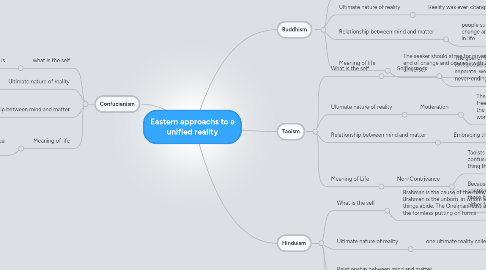
1. Confucianism
1.1. what is the self
1.1.1. spirtual understanding of what ones self is
1.2. Ultimate nature of reality
1.2.1. spirtually understanding the manner in which the world works
1.3. relationship between mind and matter
1.3.1. they linked together from spritual aspects and understanding of ones beliefs
1.4. Meaning of life
1.4.1. having a full and complete understanding of ones spirtual beliefs
2. Buddhism
2.1. What is the self
2.2. Ultimate nature of reality
2.2.1. Reality was ever-changing and inter-related
2.2.1.1. suffering is everywhere and a part of life
2.3. Relationship between mind and matter
2.3.1. people suffer because they become addicted to change and fail to recognize what truly matters in life
2.3.1.1. There is a path that leads out of suffering, known as the Noble Eightfold Path
2.4. Meaning of life
2.4.1. The seeker should strive for nirvana (the end of change and oneness with the universe)
2.4.1.1. There is a cause of suffering, which is attachment or misplaced desire (tanha) rooted in ignorance.
3. Taoism
3.1. What is the self
3.1.1. Selflessness
3.1.1.1. The goal of Taoism isn't to obliterate the ego, simply because this isn't possible. In order to stop ourselves from seeing ourselves as separate, we must see ourselves as separate, which creates a never-ending paradox
3.2. Ultimate nature of reality
3.2.1. Moderation
3.2.1.1. The ideal of unlimited freedom is an illusion. Maximum freedom is experienced when one is in the middle between the upper bound and lower bound limitations, in other words
3.3. Relationship between mind and matter
3.3.1. Embracing the Mystery
3.4. Meaning of Life
3.4.1. Non-Contrivance
3.4.1.1. Taoists embrace the mystery. They enjoy every confusion and misunderstanding and mysterious thing they see, because to them, life is a game
3.4.1.2. Because nature is dynamic, and contrived morals are stiff, contrived morals go against nature. Furthermore, the purpose for these morals are usually not better living, but greater control, either for yourself or for others
4. Hinduism
4.1. What is the self
4.1.1. Brahman is the cause of the many. Brahman is the unborn in whom all existing things abide. The One manifests as the many, the formless putting on forms
4.1.1.1. Believe in more then you, life is not about yourself it about your purpose and the belifes you hold
4.2. Ultimate nature of reality
4.2.1. one ultimate reality called Braham
4.2.1.1. The word Brahman is derived from the Sanskrit root brih - to grow- and thus suggests a reality which is dynamic and alive. The Upanishads refer to Brahman as 'this unformed, immortal, moving
4.3. Relationship between mind and matter
4.4. Meaning of life
4.4.1. the goal of each individual soul is to realize Truth
